|
Choosing the Best Apple | Apple Equivalents | Apple Preparation | Prevent Apples from Turning Brown | Apple Cooking | Tips
| Apples |
|

A round or oval shaped fruit that is harvested from lower growing trees found in most of the temperate regions of the world. The fruit has a thin skin that may range in color from shades of green, yellow, and red or any combination of these. The flesh is generally off-white or cream colored and is very juicy. They are generally sweet flavored but may be slightly sour, tart, or even a bit bland depending on the variety. Among the many varieties of common apples are the Braeburn, Cortland, Fuji, Gala, Granny Smith, Golden Delicious, Red Delicious, Jonathan, Jonagold, McIntosh, and Pacific or Southern Rose. |
|
Uses:
Apples can be eaten plain, made into sauce or jelly, or they can be included in a variety of salads, meat dishes, pies, and other desserts. As a dried fruit, apples can be added to a variety of baked goods or in a fresh form, they can be used to produce juice, vinegar, cider, and alcoholic beverages, such as hard cider and apple brandy. To determine the best variety of apple to use for your needs, see the chart below. |
|
At Their Best:
Some apple varieties are available year round and some are only available at specific times of the year. The peak season for apples will vary with different varieties and locations where they are harvested. The best apples are those that are picked fresh from the tree. Fresh picked apples will have the best flavor and an extra crisp texture. For fresh picked apples, visit local apple farms and farmers' markets during the harvest season in your location. |
|
How to Buy:
Buy apples that are brightly colored, firm, and free of bruises or damaged skin. If the flesh gives under pressure, the apple will be soft. The skin on the apple should be taut and show no signs of shriveling. Select individual apples over pre-bagged apples so that you can see what you are selecting and have an opportunity to smell the apples to make sure they have a fresh smell and are not musty. Apples are graded according to their size and quality. The higher the grade, the more expensive the apple. The end use of the apple will determine the variety of apple you should buy. See the chart below to select the best variety for your needs. |
|
Storage:
For best results, place apples in a perforated plastic bag, sprinkle with water and store in the coldest area of the refrigerator for 2 to 3 weeks. Apples give off a gas called ethylene that speeds up ripening, so they should be kept away from other fruits and vegetables to prevent them from ripening prematurely. Apples can be stored at room temperature for a short period of time but should be checked regularly because they will ripen more rapidly than if stored in the refrigerator. To store fresh picked apples for a long period of time, wrap them in paper and place folded side down in a single layer on a tray. Store in a cool, dark, dry place. The ideal temperature for storage is between 32°F and 40°F. Check frequently to see if any apples have begun to rot. Dried apples can be stored in a sealed plastic bag in the refrigerator for an indefinite period of time. |
| Varieties: |
|
Ambrosia Apple
 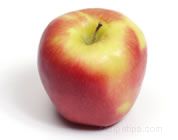 |
A medium size apple with red color with some striping on a creamy yellow background. The ambrosia apple does not have a long storage life so it should be used within approximately four months of harvesting. The apple originated from British Columbia and is a good snacking apple with its crisp texture and juicy aromatic flesh. Its flesh does not oxidize and turn brown as quickly as other apples so it works great for salads. |
|
Arkansas Black Apple
 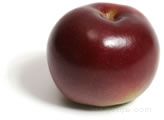
|
A small to medium size deep red apple whose red color turns to a deep purplish red and at times almost looks black. It originated in Arkansas and is thought to possible be an offshoot of a Winesap apple. It has a firm, crisp, yellow flesh that has a tart aromatic flavor. The Arkansas Black apple stores well in cold storage. It will keep its freshness for 6 months when stored properly. |
|
Baldwin Apple
 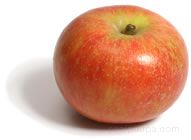 |
A red-skinned apple that has streaks of yellow and is heavily speckled with russet spots. It is an all-purpose apple has a sweet-tart flavor with a slight spiciness to it. It has a crisp texture, which holds up well when cooked. Its slightly spicy flavor makes it a good choice for making cider and pies. Baldwins are not always easy to find. |
|
Braeburn Apple
 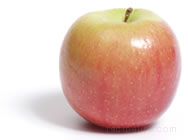 |
A variety of apple that is very firm with a sweet and slightly tart flavor. It may range in color from greenish-gold to red and is popular as a snack or served in salads and desserts. |
|
Cameo Apple
 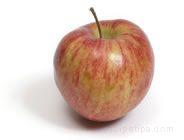 |
A fairly new variety of apple that is thought to be a cross between Red and Golden Delicious apples. It has a creamy yellow colored background with red striping over it. The Cameo apple has crisp, juicy flesh with a sweet flavor and a touch of tartness. It is a good apple for snacking and to use fresh in salads. It is also a good cooking apple and makes great desserts. The Cameo stores well when refrigerated. |
|
Connell Red Apple
 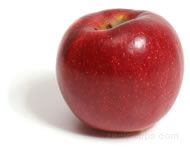 |
A large size apple that is bright solid red or striped red in color. The Connell Red is a version of Fireside but is redder in color. It is slightly crisp and has a sweet flavor, which makes it a good eating apple. Connell Red apples have a firm texture that holds up well when cooked, making it a good choice for pies and sauces. |
|
Cortland Apple
 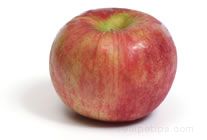 |
A type of apple that has a sweet and tart flavor with creamy white flesh covered with a vibrant red skin. It is an excellent choice for use in cooked apple dishes. |
Crab Apple
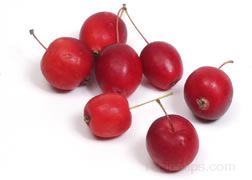 |
A variety of apple that is very small in size, usually no larger than 1 to 2 inches in diameter. The outer skin may be yellow, green or red when mature and the inner flesh is a firm to hard texture. Crab apples are known for their tart flavor and they are often used to make a jelly, wine, apple butter, and other foods. |
|
Crimson Gold Apple

|
A small variety of apple that is slightly larger than a crab apple, but much smaller than a traditional apple. The Crimson Gold Apple was developed as a cross between a Newton and Spitzenburg heirloom apple. It is a variety of apple that grows well in climates with warmer daytime temperatures with cooler evenings, to develop a higher sugar content. As it matures, this apple has a firm textured flesh that is crisp and sweet flavored. When selecting, choose apples with unblemished skins that are firm to the touch. |
|
Criterion Apple
 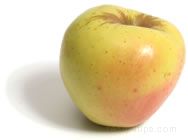 |
A bright yellow skinned apple with some areas of red blushing. It has a firm, crisp texture and a mildly sweet flavor, which makes it a good eating apple. It is slow to brown when cut open so it makes a good apple in salads and it is also makes a good cooking apple. |
|
Elstar Apple
 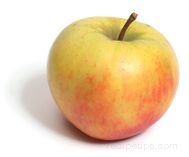 |
A cross between a Golden Delicious and Cox's Orange Pippin, it is a medium to large sized apple with a firm cream colored flesh that has a sweet but slightly tart flavor. Its skin has a yellow background streaked with a blushing of red. It is a good all-purpose apple but is excellent for making applesauce. |
|
Empire Apple
  |
A cross between a Delicious and a McIntosh apple, it is a medium sized apple and has a deep red coloring. The Empire has a crisp, juicy flesh that has a mildly tart but sweet flavor, making it a good snacking apple. It is also excellent for baking and salads. |
|
Fireside Apple
  |
A variety of apple, also referred to as a Connell Red, that is bright red and typically large in size. The smooth-textured, bright red outer skin covers a firm white flesh that is dense and fine textured, which provides a mildly sweet flavor. This apple stores well for longer periods of time in refrigerated areas. It is a good apple to eat out of hand or to use for cooking. Also, it dehydrates well as a dried fruit. |
|
Fuji Apple
 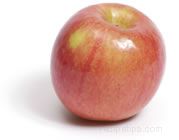 |
Ranging in color from a light yellow-green with a bit of red to all red, the Fuji apple has a sweet and spicy flavor. The natural sweetness of the apple makes it a good candidate for applesauce because little sugar is required. |
|
Gala Apple
 
|
A variety of apple that is small in size and has a skin that is yellowish-orange in color with red stripes. The flavor is sweet and not too tart, so it is a favorite as a snack. |
|
Ginger Gold Apple
  |
A variety of apple that has pale green outer skin and a cream colored crisp textured flesh. It has a slightly tart flavor that is excellent for baking, cooking or for eating as a snack. It is a variety that turns brown slowly, so it is a good choice for use in fresh cut servings. |
|
Golden Delicious Apple
 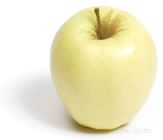
|
A variety of apple that has a pale gold and freckled skin, a firm, crisp texture, and a sweet, mellow taste. The flesh resists browning and they are excellent eaten plain or used for cooking, although they lose some of their flavor when cooked. |
|
Golden Russet Apple
 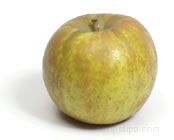 |
A medium sized apple that has a distinctive greenish yellow to golden brown skin color. The flesh is firm and cream colored providing a sweet juicy flavor. This apple is a good selection for drying, for baking, and for making cider. It can be kept for months in refrigerated storage. |
|
Golden Supreme Apple
  |
A medium sized apple that is greenish yellow to golden brown in color with a firm cream-colored flesh that provides a sweet juicy flavor. This apple is a good selection for drying, for baking, and for making cider. It can be kept for months in refrigerated storage. |
|
Granny Smith Apple
 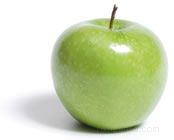 |
A tart, crisp, juicy apple with freckled green skin that is as suitable for eating as it is for cooking. Granny Smith apples are imported from New Zealand and Australia and they are also grown in the United States, mainly in California and Arizona. |
|
Gravenstein Apple
 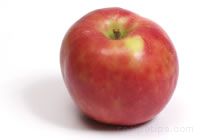 |
A type of apple that typically has a green skin streaked with red, however, it can also be mostly red in color. This apple has a texture that is crisp and juicy with a flavor that is very tart. It is considered to be an all-purpose apple because of its versatility as an ingredient for pies and applesauce as well as its flavor for eating out of hand. |
| Green Pippin |
A large sized apple with a round shape. Its green skin turns a greenish yellow when it is fully mature. Its white flesh is s tender and juicy. The Green Pippin ripens in September and stores well. |
|
Haralson Apple
  |
A variety of apple that is medium sized, bright red in color with a spot of green, and pronounced small tan-colored spots all over the outer skin. This apple has a firm white flesh that provides a distinctively tart flavor. It is an excellent apple for cooking and baking, as it is commonly used to make pies and desserts. It stores well in refrigerated areas for longer periods of time. |
|
Honeycrisp Apple
 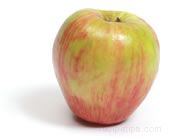 |
A variety of apple that has bright red and pale green outer skin and a cream colored crisp yet juicy inner flesh. This apple has a sweet yet slightly tart flavor and it is an excellent apple for salads, baking, cooking, or for eating as a snack. |
|
Honeygold Apple
 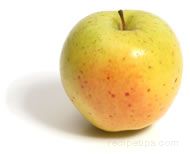 |
A medium to large sized apple that has a round cone-like shape. It is golden yellow to yellowish green in color. It frequently has a blush of red color. Its yellow flesh is sweet, similar to Golden Delicious but with a crisper texture. It is an excellent eating apple and is good in salads. Also works well for applesauce, pies and other baking. |
|
Idared Apple
 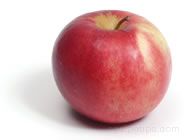 |
A variety of apple that has bright red outer skin and a cream colored crisp textured flesh. They have a slightly tart flavor and hold their shape well making them an excellent choice for baking and cooking. They are also good eating as a snack. Idared apples are also termed as Ida Red. |
|
Jazz™ Apple
 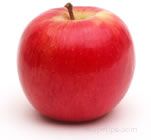 |
A new variety of apple created in New Zealand and is now making its way into the United States and other areas around the world. It is a cross between the Royal Gala and Braeburn varieties. It has an orangish red coloring over a light yellow background and a round shape. It has an exceptionally crisp texture with a tangy sweet flavor. |
|
Jonagold Apple
 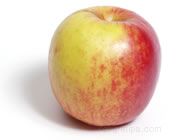 |
A variety of apple that has a creamy yellow flesh with a sweet and slightly tart flavor. The skin color is a warm red with areas of golden yellow. Jonagold apples are juicy and crisp and excellent for most cooked apple recipes or for eating as a snack. |
|
Jonamac Apple
  |
A variety of apple that has bright red outer skin and a cream colored crisp textured aromatic flesh. They have a somewhat tart flavor that is excellent for baking, cooking or for eating as a snack. |
|
Jonathan Apple
 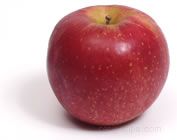 |
A very popular apple variety that is shiny red in color and has a juicy, sweet, and slightly tart flavor, and is used as a snack or in salads and desserts. The peak time of year for its availability is from early fall to late winter. |
|
Keepsake Apple
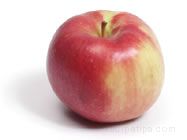 |
A small apple that has a red outer skin and a cream colored fine textured flesh. This apple has a very sweet flavor with a high sugar content and is a considered a good apple for baking, sauces or eating raw. |
|
Lady Apple
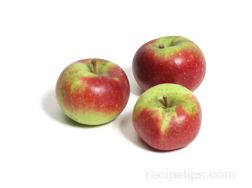 |
A small-sized apple with a green and red colored outer skin covering a white, firm textured, juicy inner flesh that provides a tart to sweet flavor. It is an apple that can be used for canning, as a garnish, for sauces, or for small snacks. Because of its size and nice appearance, this apple is commonly used to decorate wreaths and fruit baskets during Christmas, hence the reference to it as the Christmas apple. It is a variety that is, at times confused with the Pink Lady apple in name only, but is not related. The Pink Lady was developed in Australia in the early 1970's while the Lady apple is a very old apple, possibly derived from the Api family of apples. |
|
Liberty Apple
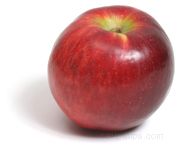 
|
A medium sized apple that is one of the most disease resistant. It has a conical shape and bright red blushed skin with a little russet around the stem. Its white flesh is crisp, juicy, sweet and just slightly acidic. It is harvested in late September and early October. |
|
Macoun Apple
 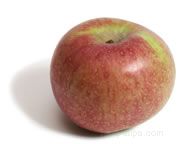 |
A small to medium size apple whose skin is colored with a rosy red blush over a green background. It has a juicy white flesh that is crisp and juicy with a taste that is sweet but slightly tart. It makes an excellent snacking apple but also works well in salads, pies and applesauce. Macoun apples are generally only available in the fall and they do not keep well. |
|
McIntosh Apple
 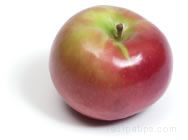 |
A light to dark red apple with tints of green covering a very juicy flesh that provides a sweet, tangy (almost tart) flavor. It makes a good eating and baking apple but when used in pies, a thickener may be necessary due to the juiciness of the apple. When storing, refrigerate the apples to keep for longer periods of time and handle them gently, since they bruise easily. |
|
Melrose Apple
  |
A variety of apple whose skin is covered in red over a green to yellowish background. The red skin is speckled with tan spots. Its white flesh is crisp and its flavor is sweet but slightly tart. It is a good eating apple and works well as a fresh apple in salads. It also makes good pies and applesauce. |
|
Mutsu Apple
  |
A greenish yellow to golden yellow colored large apple, which is a cross between a Golden Delicious and an Indo apple. Its greenish yellow skin can have a tint of orange to it at times. It has a creamy white, firm flesh that has a sweet spicy flavor. It is an excellent snacking apple and is also good for baking, salads and sauces. It is also known as a Crispin apple. |
|
Newton Pippin Apple
 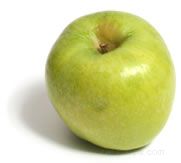 |
A good all-purpose apple that is greenish yellow in color. Its light yellow, juicy flesh is extra crispy and slightly tart. When cut or peeled, these apples have a tendency to darken quickly. They are also called Pippin Apples. |
|
Northern Spy Apple
 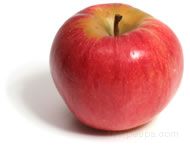
|
A large sized apple that is covered in red over a green to yellowish background. Its juicy flesh has a sweet but tart flavor and a firm texture. Because of their tartness, they are not as popular as other varieties for eating fresh. This apple is a good selection for drying and for making pies and baked goods. |
|
Northwest Greening Apple
 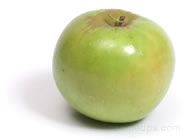 |
A variety of apple that is a cross between a Golden Russet and an Alexander. It is a large apple with pale green to yellow outer skin, with a russet area around the stem, and a cream colored firm textured flesh. It has a slightly tart flavor and is a good apple for baking or cooking. |
|
Opalescent Apple
 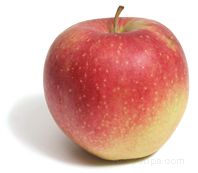 |
A very large, early ripening apple. It has a yellow skin with a red blushing covering a large portion of it. Its flesh is juicy and has a crisp texture. It has a tart flavor and is used mostly for baking. |
|
Pacific Queen™ Apple
![]() 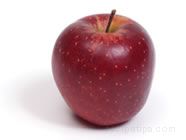 |
A variety of apple that is a result of the same Gala / Splendour cross as is Pacific Rose and also originated in New Zealand. Pacific Queen is darker red in color, has a higher sugar level and ripens earlier than Pacific Rose, but is similar in taste, providing a sweet, crisp inner flesh. This apple is often compared to the Fuji in flavor and is good for eating out of hand or for use in fruit salads. |
|
Pacific Rose™ Apple  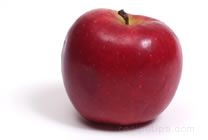 |
A variety of apple from the Pacific series of apples that originated in New Zealand. Pacific Rose is a cross between a Gala and a Splendor, with a rosy pink to bright red, thin outer skin. Inside, the flesh white, sweet, crisp and juicy. This apple has excellent storage ability. It is often compared to the Fuji in flavor and is good for eating out of hand or for use in fruit salads. |
|
Paula Red Apple
 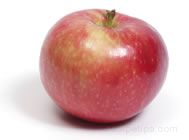 |
A variety of apple that has bright red outer skin with yellow to tan spots. This apple has a cream-colored crisp-textured juicy flesh that provides a slightly tart flavor. It is an excellent apple for baking, cooking or for eating as a snack. When making applesauce with this apple, very little sugar generally needs to be added. |
|
Piñata!® Apple
 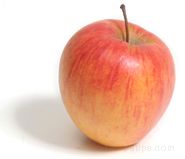
|
A medium to large size variety of apple, which is a cross between a Golden Delicious, Cox's Orange Pippin, and the Duchess of Oldenburg. This apple was originally named Pinova in Europe where it was first discovered but when a company bought the exclusive rights to grow it in the United States, they renamed it Piñata! It is slightly cone shaped and its skin has a yellowish-orange background with red striping over it. Its white flesh has a sweet flavor with a touch of acidity. It is very juicy and makes a great snacking apple. It is great when used fresh in salads because its flesh resists browning. They also are great for baking and make good sauce. |
|
Pink Lady® Brand Apple
 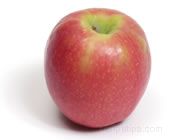 |
A medium-sized fruit that is a cross between the Golden Delicious and the Lady Williams apple. Its skin has a reddish pink coloring over a greenish yellow background. It is a firm, crisp apple with a white flesh, which has a tart-sweet flavor and resists turning brown after being sliced. The apple is used for salads and pies. To preserve the flavor of this apple, keep it refrigerated since heat decreases the texture and good taste. |
|
Pink Pearl Apple
 |
A small to medium-sized apple that has a creamy colored skin with light to dark pink blushing. The outside appearance of the apple is not as attractive as other apples but once it is cut open its beauty can be appreciated. The bright pink flesh is sure to catch anyones eye. Its pink flesh has a sweet-tart flavor, which makes it a good eating apple. It also makes good pies and sauce. This apple must be handled with care because it bruises easily. They should be used fairly soon after purchasing because they do not store as well as other varieties of apples. |
|
Pink Sparkle Apple
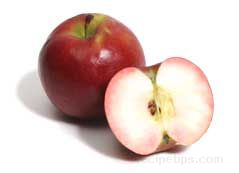 |
A medium to large-sized apple that is dark red in color with a pink and cream colored flesh. It has a round, plump shape that is broader at the base. The pink color flesh will vary in darkness depending on the climate. It has an aromatic, tart but mildly sweet flavor. It has a beautifully patterned flesh, especially when cut crosswise. It bakes well and works well in desserts. |
|
Prairie Spy Apple
 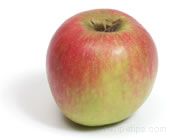 |
A hearty apple variety that is medium in size, with an outer skin that has a rosy red blush over a green background. The cream colored, firm flesh provides a tart flavor. This apple is excellent for pies and baked goods. It can be kept for months in refrigerated storage. |
|
Red Delicious Apple
 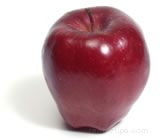 |
A large, bright red apple with an elongated shape that has five distinctive knobs on the bottom. It is deliciously sweet and juicy, making it a good apple to eat out of the hand. It does not work well for cooking. |
|
Redfree Apple
  |
A medium sized bright red apple that has creamy white flesh, which is firm and juicy. It has a sweet, mildly acidic flavor. It makes a good eating apple and works well in pies. It is an excellent drying apple. It has a shorter shelf life than some other varieties. Stores for 6 to 8 weeks. |
|
Regent Apple
 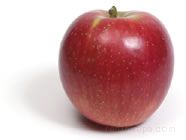 |
A mid-sized variety of apple that has bright red outer skin with pale green markings and a cream-colored crisp, juicy inner flesh. This apple has a sweet flavor similar to a Delicious apple and is an excellent apple for salads, baking, cooking, or for eating out of hand as a snack. It freezes well for keeping longer periods of time. |
|
Rhode Island Greening Apple
 |
A green to yellow colored apples that is medium sized with a russet area around the stem. The inner flesh is firm textured, white and tart flavored. It is great for pies, applesauce and other cooking needs because of its sweet-tart flavor that intensifies when it is cooked. This variety of apple is generally found in the central and eastern regions of the U.S. The variety found in the western region that compares to the Rhode Island Greening is the Northwest Greening. |
|
Rome Apple
 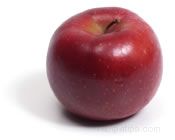 |
A round, bright red apple with an aromatic, rich flavor when cooked. The Rome is a slightly tart apple that tastes somewhat bland when eaten raw, however when cooked its flavor is enhanced. It makes a good pie and cobbler apple because is holds its texture and shape when baked. This apple is also known as Rome Beauty. |
| Sierra Beauty Apple |
A large apple that is green to yellow in color with a red blushing or streaking. It is a crisp, juicy apple with a tart flavor. It makes a good eating apple, especially for those who prefer a more tart apple. They can be used for cooking but do not hold their shape well. Sierra Beauty apples store well. |
|
Sonya Apple
  |
Originating in New Zealand, this variety of apple has been developed with a distinctive shape and flavor. The Sonya Apple is taller in shape than a traditional apple, standing more upright rather than round and stout. Covered with light red shading over a golden yellow and green background, the flesh of the Sonya Apple matures into a very sweet flavor with very little acidity. Sonya Apples are descendants of the Gala and Red Delicious varieties, with a flavor similar to the Golden or Red Delicious apples, but sweeter. |
|
Southern Rose™ Apple
 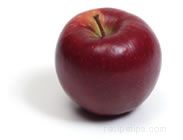 |
A variety of apple that has a fully dark red outer skin with firm white inner meat. Southern Rose was discovered in New Zealand as a chance seedling and shares many characteristics with Braeburn. Also known as "Red Braeburn," Southern Rose's flavor is tangy-sweet. It is a good apple for eating out of hand and for use in fresh-cut trays, since it resists browning naturally. |
|
Spartan Apple
 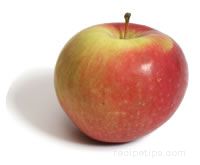 |
An all-purpose medium sized apple that is a cross between the McIntosh and the Newtown apple. It is dark red in color over a greenish yellow background and has a crisp, white flesh providing a uniquely sweet flavor. It is a great snacking apple and cooks up soft, making it excellent for applesauce. |
|
Splendor Apple
 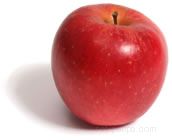 |
A fruit that comes from the Pacific Rose family of apples, this apple is a cross between a Red Dougherty and a Golden Delicious. It is a larger apple with a pinkish-red colored thin skin and a juicy, white inner flesh. The apple provides a distinctively sweet flavor and is often considered to be a dessert apple. It bruises easily, but does store very well. It can also be referred to as Splendour Apple. |
|
Spy Gold Apple
 
|
Large in size, this apple was developed as a cross between a Northern Spy and a Golden Delicious apple. Similar in size to a Northern Spy, which is slightly larger than a Golden Delicious, the Spy Gold matures into a predominatly red coloring with a gold background. Beneath the outer skin is a yellowish-white flesh that is firm and crisp in texture. The Spy Gold provides the sweet tasting flavor of a Golden Delicious and the juicy consistency of a Northern Spy. It is a good apple for pies, baking and snacking. This apple may also be referred to as a Spygold, Spigold, or Spi Gold. |
| State Fair Apple |
An early season apple that is medium sized with skin that has bright reddish-orange striping over a yellow background. It has a round, slightly conic shape. Its aromatic flesh is crisp, juicy and has a sweet but slightly tart flavor. It is one of the firmer, sweeter varieties and keeps fairly well for being one of the early seasoned apples. It is a good fresh eating apple. It is harvested beginning in the middle of August through September. |
|
Stayman Apple
 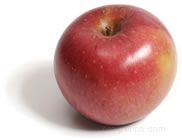 |
A medium to large red apple with skin that has areas of slight russeting. The Stayman has a juicy off-white flesh that is firm but tender and provides a sweet but slightly tart, wine-like flavor. It is a good apple for pies, sauces or eating raw. This apple keeps well in refrigerated storage. The Stayman apple is a milder offspring of the Winesap apple but is slightly larger and more elongated. Also referred to as a Stayman Winesap. |
|
Sunrise Apple
 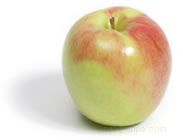 |
A medium to large sized apple that has a light yellow background that is striped with red, with more red on the exposed side. Its crisp, juicy white flesh and wonderful sweet, tart flavor makes it an excellent snacking apple. It is also a good baking apple for pies and desserts. |
|
Sweet 16 Apple
 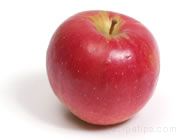 |
A medium size apple that has a red with yellow streaked outer skin and a cream colored fine textured flesh. This apple has a very sweet flavor with high sugar content and is considered a good apple for baking sauces or eating raw. |
|
Wealthy Apple
  |
An older variety of apple that is able to endure and grow well in colder climates. The wealthy is a medium to large size apple with a greenish-yellow and red outer skin covering a white to cream colored flesh. This apple provides crisp textured meat with a tart flavor. It is a variety that is often used for pies, cakes, sauces, juice, and cider. |
|
Winesap Apple
 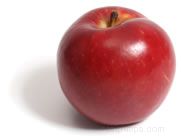 |
A small deep red apple with a juicy, yet firm, greenish yellow flesh and a tart, wine-like flavor. The Winesap apple is a good eating apple or served in salads. It is an all-purpose apple, which holds its flavor when cooked in sauces and pies. It is also often used to make cider. |
|
Wolf River Apple
  |
A very old hearty apple variety that is large in size, commonly weighing over a pound. This apple is golden green to bright red in color with a firm cream-colored flesh that provides a rich sweet flavor. The firm flesh makes it an excellent apple for sauce, for drying, for baking, and eating out of hand. |
|
York Imperial Apple
 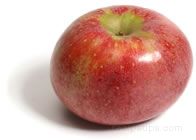 |
An apple variety characterized by its red skin, which contains streaks of yellow and russet specks and its flattened oblong shape. It has a creamy white flesh that is crisp and coarse textured. The York Imperial has a flavor that is sweet yet slightly tart. It is an excellent choice for baked desserts or for dishes cooked on the stovetop, since it holds its shape and flavor well when cooked. It is most often available during the winter months. |
|
Zestar Apple
 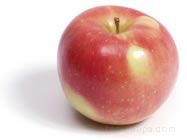 |
A variety of apple that grows well in cooler climates, Zestar apples are harvested late in the summer season. It is bright red with greenish yellow coloring, medium sized, with a crisp white grainy flesh that is very juicy and sweet in flavor. The sweet spicy flavor of this apple makes it an excellent one for snacking, as well as for baking and sauces. Store it in refrigerated areas to keep for approximately 6 to 8 weeks. |
Choosing the Best Apple
The chart below can be used as a quick reference when deciding which apple will be best for your particular needs.
| Variety of Apple |
Fresh |
Salad |
Bake |
Cook |
Pie |
Dried |
Other |
| Ambrosia |
X |
X |
|
|
|
|
|
| Baldwin |
|
|
X |
X |
|
|
Cider |
| Braeburn |
X |
X |
X |
X |
X |
|
Sauce |
| Cameo |
X |
X |
X |
|
X |
|
|
| Connell Red |
X |
|
|
|
X |
X |
Sauce |
| Cortland |
X |
X |
X |
X |
X |
|
Sauce |
| Crab Apples |
|
|
|
|
|
|
Jelly &
WineButter |
| Crimson Gold |
X |
|
|
|
|
|
|
| Criterion |
X |
X |
X |
|
X |
|
Sauce |
| Elstar |
X |
X |
X |
|
X |
|
Sauce |
| Empire |
X |
X |
X |
X |
X |
X |
|
| Fireside |
X |
X |
X |
X |
X |
X |
|
| Fuji |
X |
X |
X |
|
X |
|
Sauce |
| Gala |
X |
X |
X |
|
X |
X |
|
| Ginger Gold |
X |
X |
X |
|
|
|
Sauce |
| Golden Delicious |
X |
X |
X |
X |
X |
|
Sauce |
| Golden Russet |
X |
|
X |
|
|
X |
Cider |
| Golden Supreme |
|
|
X |
|
|
X |
Cider |
| Granny Smith |
X |
X |
X |
X |
X |
|
Sauce |
| Gravenstein |
X |
|
X |
X |
X |
|
Sauce |
| Green Pippin |
|
|
X |
|
X |
|
Sauce |
| Haralson |
X |
X |
X |
X |
X |
X |
Sauce |
| Honeycrisp |
X |
X |
X |
X |
X |
X |
Sauce |
| Honeygold |
X |
X |
X |
|
X |
|
Sauce |
| Idared |
X |
|
X |
X |
X |
X |
Sauce |
| Jonagold |
X |
X |
X |
X |
X |
|
Sauce |
| Jonamac |
X |
|
X |
X |
|
|
|
| Jonathan |
X |
X |
X |
X |
X |
X |
Sauce |
| Keepsake |
X |
|
X |
|
X |
|
|
| Lady |
X |
|
|
|
|
|
Sauce |
| Liberty |
X |
|
X |
X |
X |
|
Dessert |
| Macoun |
X |
|
X |
|
X |
|
Sauce |
| McIntosh |
X |
X |
|
X |
X* |
|
Sauce |
| Melrose |
X |
X |
X |
|
X |
|
|
| Mutsu |
X |
|
X |
X |
X |
|
Sauce |
| Newton Pippin |
X |
X |
X |
|
X |
|
Sauce |
| Northern Spy |
|
|
X |
|
X |
|
Sauce |
| Northwest Greening |
|
|
X |
X |
X |
|
Sauce |
| Opalescent |
|
|
X |
|
X |
|
|
| Pacific Queen |
X |
X |
|
|
|
|
|
| Pacific Rose |
X |
X |
|
|
|
|
|
| Paula Red |
X |
X |
X |
X |
X |
|
Sauce** |
| Piñata! |
X |
X |
X |
X |
X |
|
Sauce |
| Pink Lady |
X |
X |
X |
|
X |
|
Sauce |
| Pink Pearl |
X |
|
X |
|
X |
|
Sauce |
| Pink Sparkle |
|
|
X |
|
X |
|
|
| Prairie Spy |
X |
X |
X |
|
X |
|
Sauce |
| Red Delicious |
X |
X |
|
|
|
|
|
| Redfree |
X |
|
|
|
X |
X |
|
| Regent |
X |
X |
X |
X |
X |
|
Sauce |
| Rhode Island Greening |
X |
|
X |
X |
X |
|
Sauce |
| Rome |
|
|
X |
X |
X |
|
Sauce |
| Sierra Beauty |
X |
|
|
X |
|
|
|
| Sonya |
X |
X |
X |
X |
X |
|
Sauce |
| Southern Rose |
X |
X |
|
|
|
|
|
| Spartan |
X |
X |
X |
|
X |
X |
Sauce |
| Splendor |
X |
|
|
|
|
|
Dessert |
| Spy Gold |
X |
|
X |
|
X |
|
|
| State Fair |
X |
X |
|
X |
X |
|
Sauce |
| Stayman |
X |
X |
X |
X |
X |
|
|
| Sunrise |
X |
|
X |
|
X |
|
|
| Sweet 16 |
X |
|
X |
|
|
|
Sauce |
| Wealthy |
X |
|
X |
X |
X |
|
Sauce |
| Winesap |
X |
X |
X |
|
X |
|
Sauce |
| Wolf River |
X |
|
X |
X |
|
X |
Sauce |
| York Imperial |
|
|
X |
X |
X |
|
Sauce |
| Zestar |
X |
|
X |
|
X |
|
Sauce |
*May need a thickener when used in pies because of the juiciness of the apple.
**Very little sugar needs to be used when making applesauce with Paula Red Apples.
Apple Equivalents
Apples come in many sizes and shapes, which makes it difficult at times to know what quantity to buy when a specific amount or size is called for. The information below is provided to assist in figuring out how much or how many to buy.
| Approximate Apple Sizes (Size will vary between varieties) |
| Size |
Diameter |
Approximate Weight |
Apples per Pound |
| Small |
2 1/4" |
4 oz. |
4 |
| Medium |
2 3/4" |
5 oz. to 7 oz. |
3 |
| Large |
3 3/4" |
8 oz. or more |
2 |
Apple Equivalents
Quantities are approximate amounts.
Quantities may change slightly due to varying apple sizes. |
| Quantity of Apples |
Sliced |
Diced |
Grated |
Sauce |
| 1 Small |
5/8 to 3/4 C. |
3/4 C. |
1/2 C. |
1/3 C. |
| 1 lb. - 4 Small |
2 3/4 C. |
3 C. |
2 C. |
1 1/3 C. |
| 1 Medium |
7/8 to 1 C. |
1 C. |
3/4 C. |
1/2 C. |
| 1 lb. - 3 Medium |
2 3/4 C. |
3 C. |
2 1/4 C. |
1 1/2 C. |
| 1 Large |
1 3/8 to 1 1/2 C. |
1 1/2 C. |
1 1/2 C. |
3/4 C. |
| 1 lb. - 2 Large |
2 3/4 C. |
3 C. |
3 C. |
1 1/2 C. |
| Miscellaneous Apple Equivalents |
| 2 to 1 1/2 lbs. |
One 9" Pie |
| 1 Peck |
10 1/2 to 12 lbs. |
| 1 Bushel |
42 lbs. |
20 - 24 quarts - Applesauce
18 - 20 quarts - Canned or Frozen Slices |
|
1 C. Dried Apples |
Approximately 1 1/4 C. Cooked Apples |
Apple Preparation
Preparation Tools | Removing the Core | Peeling the Apple | Cutting Apples
Most apples can be eaten out of hand just as they are or they can be cored, peeled and sliced first. Generally, if they are going to be cooked or used in other food dishes, the apples must be prepared in some manner. Some of the tools that are used and the common preparation methods called for in recipes are shown below.
Preparation Tools
|
Apple Corer
A tool used to extract the core from the apple without cutting the apple into sections and then individually cutting out each part of the core. This tool has a circular cutting edge that is forced down into the apple, allowing the apple to remain whole so it can then be easily sliced into sections for eating it out of hand or baking it whole with the outer skin intact. |
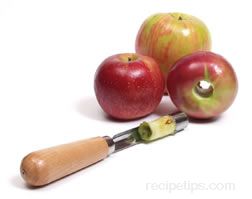 |
|
Apple Peeler
A tool used to trim the outer skin of an apple from the apple flesh. This device will most often remove the core while removing the skin around the apple, leaving it cored and either whole or sliced.
|
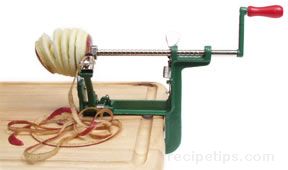 |
|
Apple Wedger
A kitchen utensil that is used to cut whole apples into individual sliced wedges, while also cutting around the core so that the seeds and core can be easily discarded. This tool is generally made of aluminum or stainless steel with sharp blades that are formed to slide smoothly through the flesh of the fruit. |
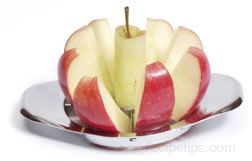 |
Removing the core:
Apples can be cored using several methods. As shown above, an apple corer can be inserted down through the middle and pulled back out to remove the core. If the apple is to be stuffed with other ingredients and then baked, the blossom end of the apple should be left intact with approximately 1/2 inch remaining. If the apples need to be peeled, they can be peeled before or after the core is removed. A problem that can occur when using the apple corer is that all the seeds may not get removed because the diameter of the corer is not wide enough. The remaining seeds can be removed by using a paring knife to scrape them out.
If you do not have an apple corer to remove the core, you can remove it by using one of the methods shown below.
Whole Apple - Paring Knife:
Using a sharp paring knife, insert it in the apple along side the core and cut around the entire core.
After cutting around the core, remove it by pulling it from the center of the apple. It may be helpful to use the paring knife to assist in prying the core out until it is out far enough to get a firm grip with your fingers.
If some seeds remain in the apple, use the knife to cut more out of the center until all seeds are removed.
|
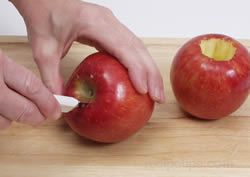
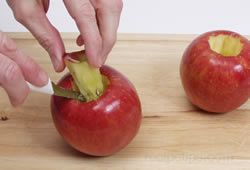
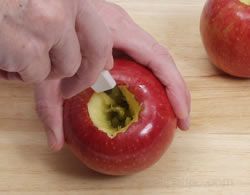
|
|
Whole Apple - Melon Baller:
A melon baller can also be used to remove the core from an apple.
Begin scooping the core out from the stem end of the apple.
Continue to remove the core from the cavity of the apple by inserting the melon baller and using a twisting motion to scoop the core from the center of the apple. If the apple is going to be stuffed, be sure to leave approximately 1/2 inch at the blossom end of the core. |
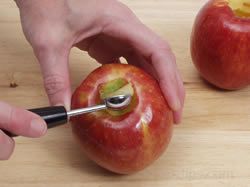
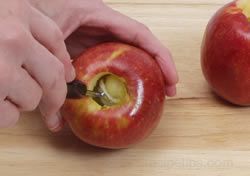
|
| Quarter Sections:
If it isn't required that the apple remain whole, the following method can be used to remove the core.
The apple can be peeled or left unpeeled. Cut the apple in half lengthwise from stem to blossom end. Cut in half again to form quarters.
Using a sharp knife, cut at an angle starting at one end and cut to the middle of the section.
Starting at the opposite end cut to the middle, meeting the first cut.
Remove the core from the quarter section. Using the same method, remove the core from the remaining sections. |
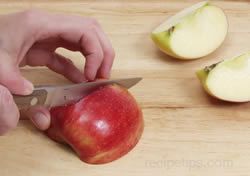

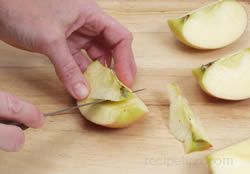
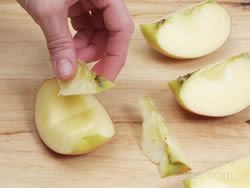
|
Peeling the Apple
Apples can be peeled by using an apple peeler, which is a tool used to trim the outer skin off apples. This device will most often remove the core while removing the skin around the apple, leaving it cored and either whole or sliced. If you are peeling a lot of apples, this device can save you a lot of time. If you do not have an apple peeler or do not have a need for peeling a large quantity of apples, you can peel the apples by hand using one of the methods below.
|
Whole Apples:
Using a vegetable peeler or a sharp knife, peel a thin layer of skin by cutting strips around the apple. Start at the stem end and work down towards the blossom end.
Apples can also be peeled by cutting thin vertical layers, starting at the stem end and peeling down to the blossom end. Continue to peel vertical strips by overlapping the previous cut until the all the skin has been removed from the surface of the apple. |
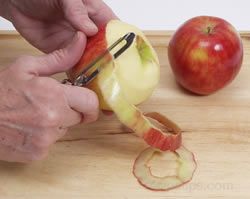

|
|
Quarter Sections:
The apple can also be peeled after it has been cut into quarters.
Cut apples into quarters and remove core as shown above.
Using a sharp knife or vegetable peeler, peel thin vertical strips from each of the quartered sections. |

|
Cutting Apples
Apples can be cut in many shapes and sizes, such as rings, slices, wedges, and triangles. They can also be diced, julienned and shredded. Generally the end use of the apple will determine how it is to be cut. The larger cut pieces are often used in recipes where the apple will be cooked in some manner. The smaller pieces are used in recipes where the apple will not be cooked, such as in a salad. Refer to the recipe for suggested cutting instructions. Shown below are some common options for cutting apples.
|
Apple Rings:
Remove the core and seeds from the apple. If desired or called for in the recipe, peel the skin from the apple.
To make the apple rings, lay the apple on its side and cut slices to desired thickness. |
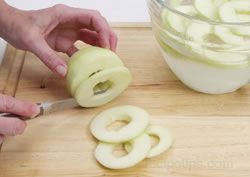 |
|
Apple Slices:
Cut apples into quarters and remove core as shown above.
Using a sharp knife, cut the quarters into slices by placing the apple core side down and cutting into 1/8 to 1/4 inch slices. Thickness will depend on end use. If you want the apples to hold their shape, cut at least 1/4 inch thick.
Cut across apple quarters for recipes with shorter cooking times. This will create a shorter slice that will cook faster. |
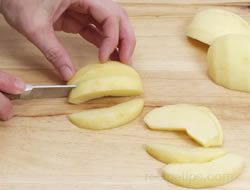
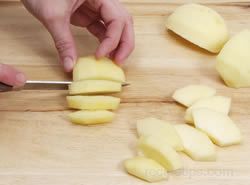
|
|
Apple Wedges and Triangles:
Cut apples into quarter sections and remove the core. Peel if desired.
Wedges - To create apple wedges, cut quartered sections lengthwise into 2 or 3 sections, depending on desired thickness.
Wedges can also be cut with a tool called an apple wedger. See Preparation Tools above.
Triangles - Cut wedges as shown above. Stack wedges from one quarter on top of each other. Cut wedges crosswise to desired thickness to form triangles. |

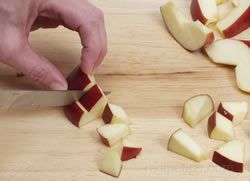
|
|
Diced and Julienned Apples:
Place peeled and cored apple quarters with one flat side down. Cut the apple section lengthwise into 1/4 inch thick pieces.
Turn the pieces so they are stacked on top of each other, parallel to the cutting surface and cut again into 1/4 inch sections.
To Dice - Cut the 1/4 inch thick sections crosswise at 1/4 inch intervals to form 1/4 inch cubed pieces.
To Julienne - Instead of cutting the 1/4 inch sections crosswise, cut them in half lengthwise. This will form 1/8 x 1/4 inch sections.
Stack the two sections on top of each other with the 1/4 inch width parallel to the cutting surface. Cut in half again, lengthwise, to form 1/8 inch thick squared sticks. |
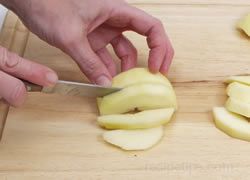
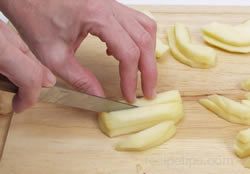

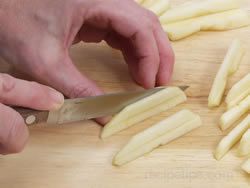
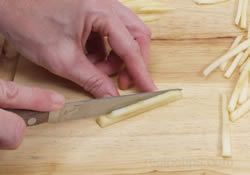
|
|
Note: When working with apples be sure to immerse in acidulated water as stated above to prevent them from turning brown. |
Prevent Apples from Turning Brown
When fresh apples are peeled or cut open, the apple's cells are exposed and react with the oxygen in the air. The reaction that occurs, which is called oxidation, is what turns the apple brown. When an apple is bruised the same type of reaction has occurred. If an apple is damaged by being hit or dropped, the apple's cells in that area are damaged and exposed to the air inside the apple, causing them to turn brown. When preparing apples for use, an anti-browning solution should be used to prevent the apples from turning brown.
|
Anti-Browning Solution
There are several methods that can be used to prevent browning. One method is to brush the surface of the apple with lemon juice.
|
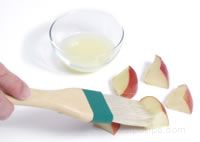 |
|
Another method is to place the apples in water that has had lemon juice or cider vinegar added to make it acidulated. The squeezed lemon can also be cut into slices and added to help acidulate the water. Juice from other citrus fruit can also be used, such as oranges and grapefruit. Use approximately 1/4 cup lemon juice to 1 quart of cold water.
Do not over soak the apples. Drain and pat dry before using. |
 |
|
Other Options:
- Ascorbic acid, a commercial product, can also be added to water to create an anti-browning solution.
- Dip the slices in lemon-lime soda.
- Soak apples slices in apple juice until ready to use. The acidity in the apple juice prevents the apple slices from browning and doesn't change the flavor of the apple.
|
Apple Cooking
Baked Apples | Fried Apples | Cooking Applesauce | Drying Apples
Apples can be cooked using many methods. They can be cooked on their own and eaten as a side dish or added with other ingredients to create a main dish. Cooked apples go well with meats, such as ham, pork, and poultry. They are also added in many desserts and baked goods. There are many different recipes and methods used for cooking apples. Shown below are some basic cooking methods that can be used for apples.
Baked Apples
There are many recipes and different techniques used to bake apples. The apples may be left whole, unpeeled, and cores removed, or they may have a portion peeled and skins left on the remainder. Some recipes will call for the apples to be cut in half first and then the cores removed. Generally the recipe will have some type of filling that is added to the cavity of the apple before baking. The filling may be as simple as butter and brown sugar or it may consist of a mixture of several ingredients, such as butter, sugar, brown sugar, syrup, honey, apple juice, water, cinnamon, nutmeg, dried fruit, and nuts. The recipe used below is just one of many using some of these ingredients.
|
Preheat oven to 350?F.
Remove the core, as shown in Apple Preparation, from four baking apples (see chart above for selection of baking apples).
Score around the perimeter of the apple in several locations to prevent the skin form rupturing during baking. |
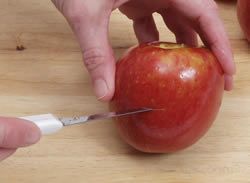 |
|
Place the apples in a baking dish with the blossom side down. |
 |
|
In the cavity of each cored apple place 1 tsp. of butter or margarine. |
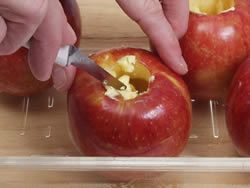 |
|
Pour 1/2 tbsp. of sugar on top of the butter in the cavity of the apples. |
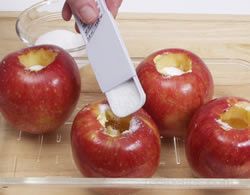 |
|
Bake for 50 to 60 minutes or until apples are tender when poked with a fork. |
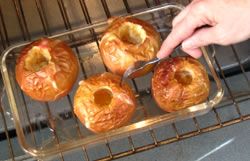 |
|
In a small bowl combine 1/4 cup of brown sugar, 2 tsp. of flour, 1/4 tsp. of cinnamon, and 2 tsp. of water. Stir until well blended.
Spoon mixture over the baked apples and place back in the oven for 10 to 15 minutes. Serve while still warm. |
 |
Fried Apples
Apples may be cut into rings, wedges, or slices for frying. They may also be peeled or unpeeled, depending on the recipe. Apples are generally fried in butter and either white sugar or brown sugar, which helps them keep their shape. Some recipes will call for other ingredients, such as cinnamon, nutmeg, salt, egg, and water. Sausage and bacon grease are also used in place of butter in some recipes when frying apples. The recipe below makes a side dish of fried apples that goes well with ham or pork.
Cooking Applesauce
Applesauce is a popular food that is simple to cook and made with few ingredients. The basic ingredients consist of cooking apples, sugar and water. Other ingredients, such as cinnamon, nutmeg, cloves, lemon juice or zest, and apple cider, can be added to enhance the flavor. The recipe below is for a simple applesauce, using basic ingredients.
|
Peel five to six medium cooking apples (see chart above for selection of cooking apples). Cut apples in half and then into quarters.
|

|
| Remove the core from the quartered sections. |
 |
|
Cut quartered apples into thick slices.
Place slices immediately in water with lemon juice to prevent browning. Do not allow apples to soak for more than 15 minutes. |
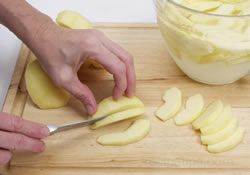 |
| Add 1/2 cup of cold water to a heavy 2-quart saucepan. Drain slices and add them to the saucepan. |
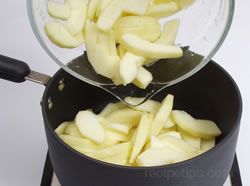 |
| Bring apples and water to a boil over medium heat. Cover apples and reduce heat to low. For chunky sauce simmer apples for 8 to 10 minutes. For smoother applesauce, simmer for 12 to 15 minutes. |
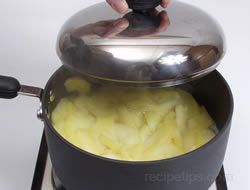 |
| Add 1/2 cup of sugar during the last 2 or 3 minutes of cooking time. |

|
| Stir sugar into the sauce and finish cooking to desired consistency. |
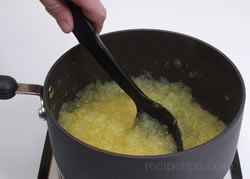 |
| The applesauce can be served warm or chilled. Before storing in the refrigerator, allow the applesauce to cool and then place in a sealed container. |
 |
Drying Apples
Drying apples removes the moisture from the apple, leaving it with a concentrated flavor. Dried apples make a sweet nutritious snack and are easy to store. They can also be reconstituted (see below) for use in sweet and savory dishes. There are several methods that can be used to dry apples. They can be sun dried, oven dried, or dried in a dehydrator. The different methods are explained below.
|
Preparation:
Rings - Peel apples and leave whole. Remove the core and slice apples into 1/8 thick rings.
Slices - Peel apples and cut into quarters. Remove the core and cut sections into 1/8 inch thick slices. |

|
| Place slices immediately in water with lemon juice to prevent browning. Allow the slices to soak for a few minutes and drain. Pat the slices dry with paper towels. |
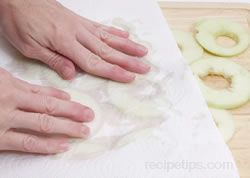 |
|
Sun Drying:
Place prepared slices or rings in a single layer on a wire rack placed on a baking sheet. Do not allow apple sections to be touching. Cover with cheesecloth and place in the sun in a well ventilated area.
Turn slices every couple of hours. Bring apples in at night. The drying process will take 2 to 3 days. This is not the preferred method for drying since it is slow and the drying process is hard to control. |
|
Oven Drying:
Place prepared slices or rings in a single layer on a wire rack placed on a baking sheet. Do not allow apple sections to be touching. |
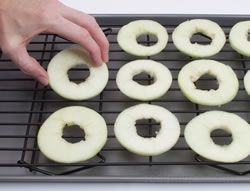
|
| Place, uncovered, in an oven preheated between 125? to 150? F. Dry for 6 to 8 hours, turning after four hours and checking for dryness after six hours. If not dry, check again after two more hours. |
 |
| Apples are dried sufficiently when no moisture remains in the middle of slice when it is torn open. The dried apples will be pliable with a leathery texture. |
 |
|
Drying in Dehydrator:
Using a dehydrator is the most consistent method for drying.
Prepare in same manner as above. Place slices or rings on the trays of the dehydrator, being careful that the apples do not touch. This allows more even air movement during drying time.
|
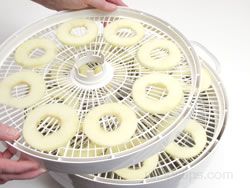
|
| See the dehydrator manufacturer's manual for suggested drying time. Turn slices or rings over about half way through the drying time and rotate dehydrator trays. |
 |
| After the apples have dried sufficiently, allow them to cool completely and then store in sealable plastic bags or covered plastic or glass containers. Store in the refrigerator or in a dark area where it is cool and dry. |
|
Reconstituting Dried Apples |
|
Method 1:
Place the dried apples in a saucepan and cover with an equal amount of water or apple cider. Should be enough liquid to cover the dried apples.
Bring liquid to a boil, cover, and reduce heat to a simmer. Allow to simmer for approximately 30 minutes or until apples are at the desired tenderness.
Drain and prepare as desired.
|
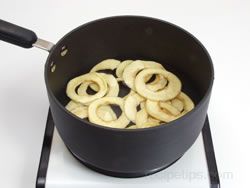
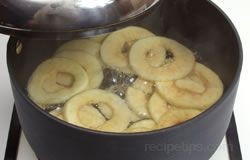
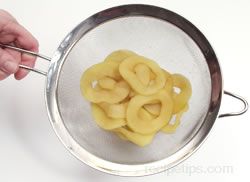
|
|
Method 2:
- Place dried apples in a heatproof bowl.
- Heat equal amounts of water or apple cider to a boil and pour over dried apples.
- Allow apples to stand for 1/2 to 2 hours, until they are at the desired tenderness.
- Drain and prepare as desired.
|
Tips
- Apples give off a natural gas called ethylene, which speeds the ripening process for other fruits. To speed the ripening of other fruits, place an apple, with the unripe fruit, in a paper bag. Seal and make a few slits in the bag. Allow the bag to stand at room temperature for 2 to 3 days.
- Cooked apples will hold their shape better if the sugar called for in the recipe is added at the start of the cooking process.
- Use a greased muffin tin to place apples in for baking. The tins will provide support for the baked apple.
- Old apples that have begun to deteriorate can be revived by peeling, cutting into chunks, and then soaking in cold apple cider or juice for approximately 30 minutes. Place in refrigerator while soaking.
- To keep apples longer, store them so that they are not touching each other.
|

